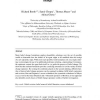Free Online Productivity Tools
i2Speak
i2Symbol
i2OCR
iTex2Img
iWeb2Print
iWeb2Shot
i2Type
iPdf2Split
iPdf2Merge
i2Bopomofo
i2Arabic
i2Style
i2Image
i2PDF
iLatex2Rtf
Sci2ools
AI
2010
Springer
2010
Springer
Double preference relations for generalised belief change
Many belief change formalisms employ plausibility orderings over the set of possible worlds to determine how the beliefs of an agent ought to be modified after the receipt of a new epistemic input. While most such possible world semantics rely on a single ordering, we investigate the use of an additional preference ordering--representing, for instance, the epistemic context the agent finds itself in--to guide the process of belief change. We show that the resultant formalism provides a unifying semantics for a wide variety of belief change operators. By varying the conditions placed on the second ordering, different families of known belief change operators can be captured, including AGM belief contraction and revision, Rott and Pagnucco's severe withdrawal, the systematic withdrawal of Meyer et al, as well as the linear liberation and -liberation operators of Booth et al. Our approach also identifies novel classes of belief change operators worthy of further investigation. Key w...
| Added | 08 Dec 2010 |
| Updated | 08 Dec 2010 |
| Type | Journal |
| Year | 2010 |
| Where | AI |
| Authors | Richard Booth, Samir Chopra, Thomas Meyer, Aditya Ghose |
Comments (0)

